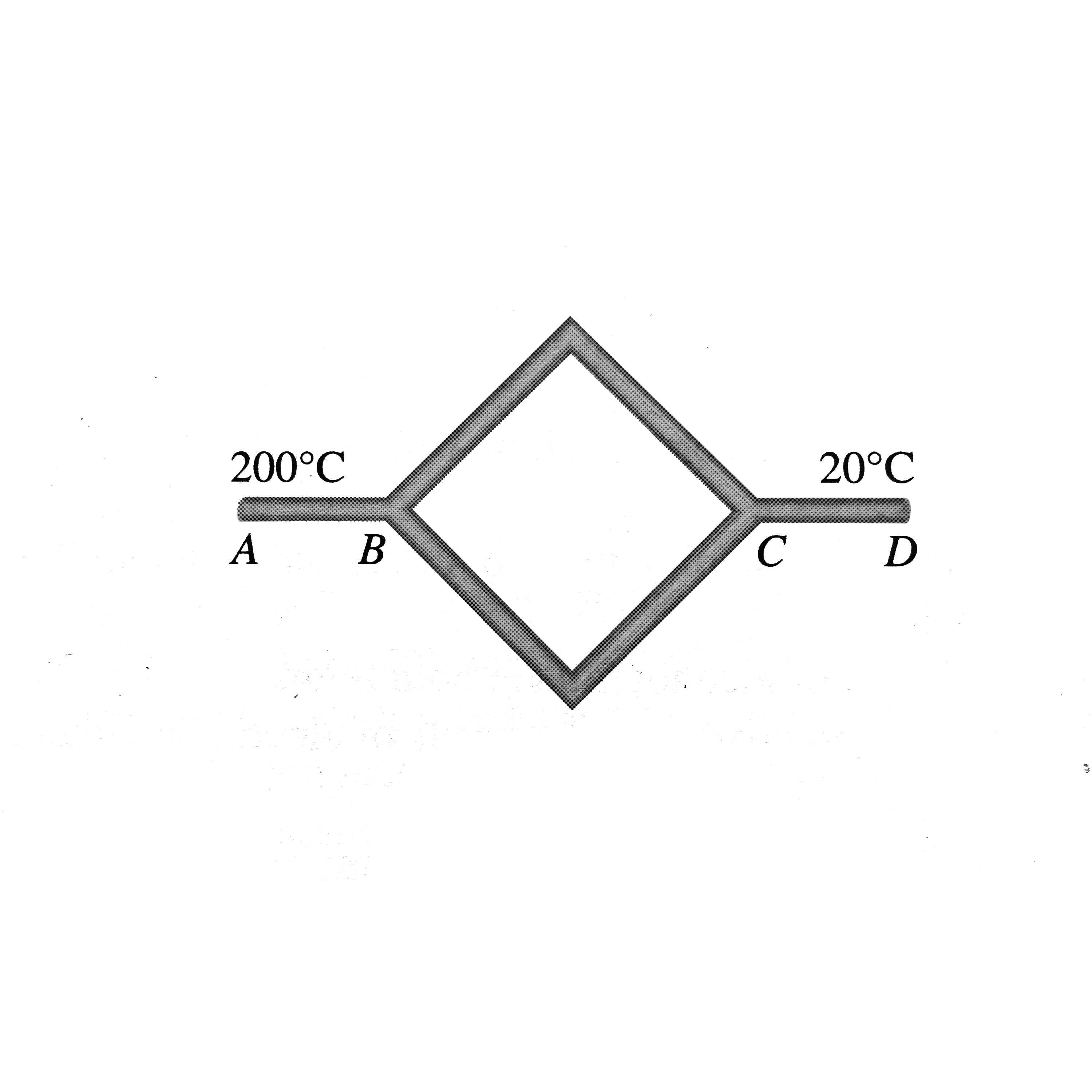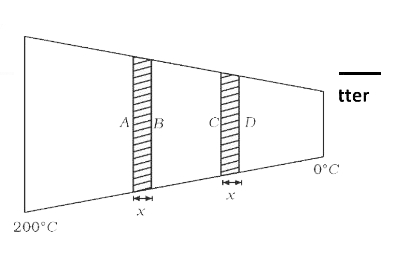The two ends of a metal rod are maintained at temperature 100∘C and 110∘C. The rate of heat flow in the rod is found to be 4.0J/s. If the ends are maintained at temperature s 200∘C and 210∘C. The rate of heat flow will be
44.0J/s
16.8J/s
8.0J/s
4.0J/s
The correct Answer is:D
To solve the problem, we will use the principle of heat conduction, which is described by Fourier's law of heat conduction. The rate of heat flow (Q/t) through a material is proportional to the temperature difference (ΔT) across it, given by the formula:
Qt=k⋅A⋅ΔTx
Where:
- Q/t is the rate of heat flow (in Joules per second),
- k is the thermal conductivity of the material,
- A is the cross-sectional area of the rod,
- ΔT is the temperature difference across the rod,
- x is the length of the rod.
1. Identify the initial conditions:
- For the first scenario, the temperatures at the ends of the rod are T1=100∘C and T2=110∘C.
- The temperature difference ΔT1=T2−T1=110∘C−100∘C=10∘C.
- The rate of heat flow is given as Q/t=4.0J/s.
2. Identify the new conditions:
- For the second scenario, the temperatures at the ends of the rod are T′1=200∘C and T′2=210∘C.
- The temperature difference ΔT2=T′2−T′1=210∘C−200∘C=10∘C.
3. Compare the temperature differences:
- We observe that ΔT1=10∘C and ΔT2=10∘C.
4. Apply Fourier's law:
- Since the rod's material (thermal conductivity k), cross-sectional area A, and length x remain constant, we can conclude that the rate of heat flow is directly proportional to the temperature difference.
- Therefore, if ΔT1=ΔT2, then the rate of heat flow in both cases will be the same.
5. Conclude the result:
- Since the temperature differences are equal, the rate of heat flow in the second case will also be 4.0J/s.
Final Answer:
The rate of heat flow when the ends are maintained at 200∘C and 210∘C will be 4.0J/s.
- Q/t is the rate of heat flow (in Joules per second),
- k is the thermal conductivity of the material,
- A is the cross-sectional area of the rod,
- ΔT is the temperature difference across the rod,
- x is the length of the rod.
- For the first scenario, the temperatures at the ends of the rod are T1=100∘C and T2=110∘C.
- The temperature difference ΔT1=T2−T1=110∘C−100∘C=10∘C.
- The rate of heat flow is given as Q/t=4.0J/s.
- For the second scenario, the temperatures at the ends of the rod are T′1=200∘C and T′2=210∘C.
- The temperature difference ΔT2=T′2−T′1=210∘C−200∘C=10∘C.
- We observe that ΔT1=10∘C and ΔT2=10∘C.
- Since the rod's material (thermal conductivity k), cross-sectional area A, and length x remain constant, we can conclude that the rate of heat flow is directly proportional to the temperature difference.
- Therefore, if ΔT1=ΔT2, then the rate of heat flow in both cases will be the same.
- Since the temperature differences are equal, the rate of heat flow in the second case will also be 4.0J/s.
The rate of heat flow when the ends are maintained at 200∘C and 210∘C will be 4.0J/s.
Topper's Solved these Questions
- THERMAL PROPERTIES OF MATTERBOOK - A2ZCHAPTER - THERMAL PROPERTIES OF MATTEREXERCISE - AIIMS Questions
28 Videos
- THERMAL PROPERTIES OF MATTERBOOK - A2ZCHAPTER - THERMAL PROPERTIES OF MATTEREXERCISE - Chapter Test
30 Videos
- THERMAL PROPERTIES OF MATTERBOOK - A2ZCHAPTER - THERMAL PROPERTIES OF MATTEREXERCISE - Assertion Reasoning
21 Videos
- ROTATIONAL DYNAMICSBOOK - A2ZCHAPTER - ROTATIONAL DYNAMICSEXERCISE - Chapter Test
29 Videos
- UNIT, DIMENSION AND ERROR ANALYSISBOOK - A2ZCHAPTER - UNIT, DIMENSION AND ERROR ANALYSISEXERCISE - Chapter Test
28 Videos
Similar Questions
The ends of metal road are maintained at temperature 120°C and 150°C. The rate of heat flow in the road is to be found to be 10Js. If an identical rod is connected in parallel with this rod and ends temperature are maintained at 220°C and 250°C, then net rate of flow of heat will be
View Solution
Six identical cunducting rods are joined as shown in Fig. Points A and D are maintained at temperatures 200∘C and 20∘C respectively. The temperature of junction B will be
View Solution
Knowledge Check
The two ends of a metal rod are maintained at temperatures 100∘C and 110∘C . The rate of heat flow in the rod is found to be 4.0j/s. If the ends are maintaind at temperatures 200∘C and 210∘C, the rate of heat flow will be :
A16.8j/sB8.0j/sC4.0j/sD44.0j/sThe two ends of a metal rod are maintained at temperatures 100∘C and 110∘C. The rate of heat flow in the rod is found to be 4.0 J/s. If the ends are now maintained at temperatures 200∘C and 210∘C, the rate of flow of heat will be
A16.8 j/sB8.0 J/sC4.0 J/sD44.8 J/sThe two ends of a metal rod are maintained at temperatures 100∘C and 110∘C . The rate of heat flow in the rod is found to be 4.0j/s. If the ends are maintaind at temperatures 200∘C and 210∘C, the rate of heat flow will be :
A16.8J/sB8.0J/sC4.0J/sD44.0J/s
One end of conducting rod is maintained at temperature 50∘C and at the other end ice is melting at 0∘C. The rate of melting of ice is doubled if:
View SolutionThe ends of a metal rod are kept at temperatures θ1 and θ2 with θ2>θ1. The rate of flow of heat along the rod is directly proportional to
View SolutionTwo rods of same material and thickness are joined as shown below. The ends X and Y are maintained at X∘C and Y∘C respectively. The ratio of the heat flow in the two rods is –

View SolutionTwo ends of a conducting rod of varying cross-section are maintained at 200∘Cand0∘C respectively. In steady state :

View SolutionTwo ends of a conducting rod of varying cross-section are maintained at 200∘C and 0∘C respectively. In steady state:

View Solution